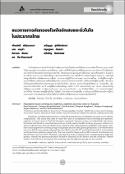บทคัดย่อ
โรคไตอักเสบและโรคนิ่วในไตเป็นโรคที่พบบ่อยในคนไทยที่อาจก่อให้เกิดภาวะแทรกซ้อนเรื้อรังและรุนแรง แต่ยังไม่มีแนวทางคัดกรองระดับประชากรที่ชัดเจน บทความนี้จึงมีวัตถุประสงค์เพื่อเสนอแนวทางการคัดโรคไตอักเสบและโรคนิ่วในไตระดับประชากรในประเทศไทย โดยทบทวนวรรณกรรมอย่างเป็นระบบ ผลการศึกษาพบว่า ถึงแม้การตรวจปัสสาวะและการตรวจเลือดเพื่อดูการทำงานของไตเป็นการตรวจที่ได้รับความนิยมในชุดตรวจสุขภาพ แต่ยังไม่มีหลักฐานยืนยันประสิทธิผลและความคุ้มค่า แนวทางเวชปฏิบัติในต่างประเทศ และประเทศไทย รวมถึงผู้เชี่ยวชาญไม่แนะนำให้คัดกรองด้วยการตรวจเลือดเพื่อดูการทำงานของไตในประชากรทั่วไป แต่คัดกรองในผู้มีความเสี่ยง อัตราส่วนค่าต้นทุนประสิทธิผลในการคัดกรองประชากรทั่วไปเท่ากับ ๒๘๒,๘๑๘ ดอลลาร์สหรัฐต่อปีสุขภาวะ ในกลุ่มเสี่ยง เช่น อายุมากกว่าหรือเท่ากับ ๖๐ ปี และมีความดันโลหิตสูง เท่ากับ ๕๓,๓๗๒ ดอลลาร์สหรัฐ และ ๑๘,๖๒๑ ดอลลาร์สหรัฐต่อปีสุขภาวะตามลำดับ การคัดกรองประชากร ๘๐๐ คนจะพบโรคไต ๑ คน จึงเสียค่าใช้จ่าย ๒,๗๗๙ ดอลลาร์สหรัฐต่อการวินิจฉัย โอกาสตรวจพบผู้ป่วยมีน้อย ไม่คุ้มค่า ควรคัดกรองในกลุ่มเสี่ยง ร่วมกับรณรงค์ให้ประชากรมีความรู้และการตระหนัก และสนับสนุนการศึกษาวิธีคัดกรองที่มีประสิทธิผลและเหมาะสมต่อกลุ่มเสี่ยงต่อไป
บทคัดย่อ
Nephrosis, nephritis and renal stone, commonly found diseases in Thailand, can cause severe chronic
complications. This article thus aims to study the value of a population-based screening for nephrosis,
nephritis and renal stone in Thailand through a systematic literature review and stakeholder discussion.
Urinalysis and blood for renal function tests are widely used in health check-up programs without evidence
of effectiveness and cost-effectiveness. Analysis of the clinical practice guidelines and experts’ opinions
found support for screening in high-risk groups, but not in the general population. Cost-effectiveness
ratio was $282,818 per quality-adjusted life year (QALY), but $53,372 and $18,621 per QALY, in the elderly
and hypertensive patients, respectively. One case would be diagnosed per 800 screened. Incremental costeffectiveness
ratio was $2779. Therefore, renal function tests or urinalysis are recommended for high-risk
groups, whereas the general population should be educated on the disease and risk reduction. Further
studies of the effective and appropriate screening tests for high-risk groups are also needed.


